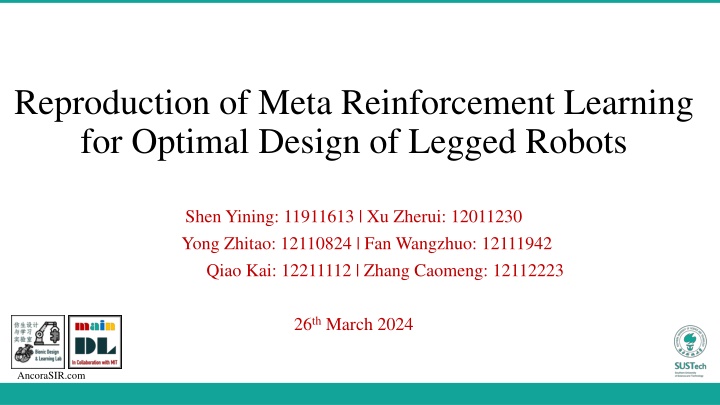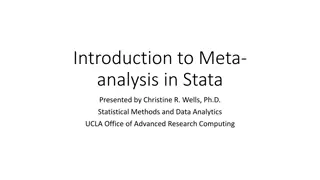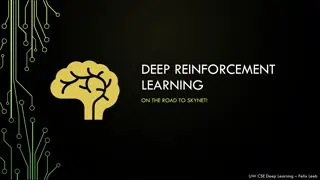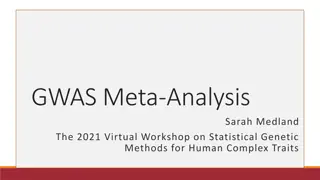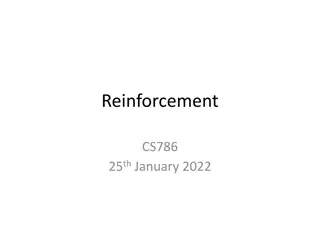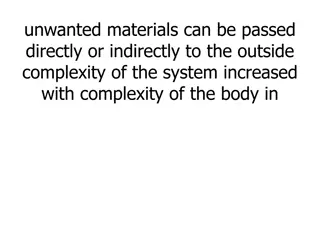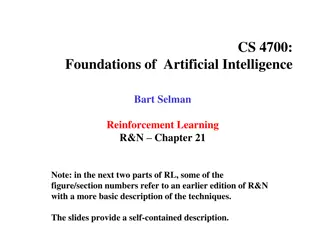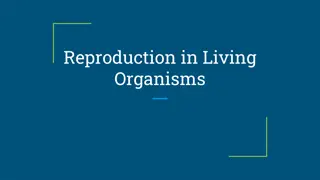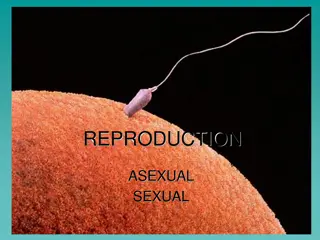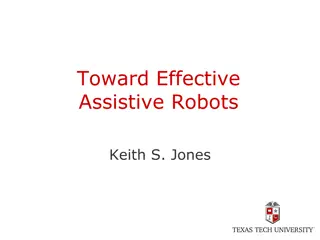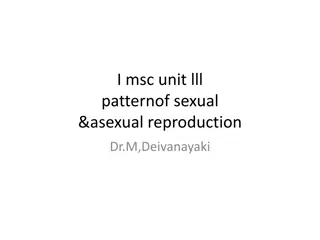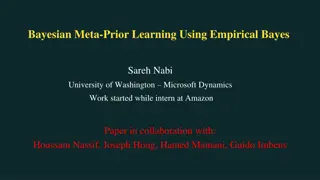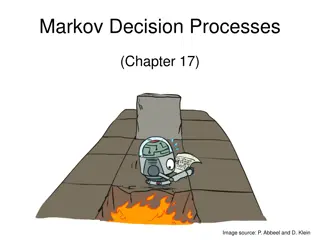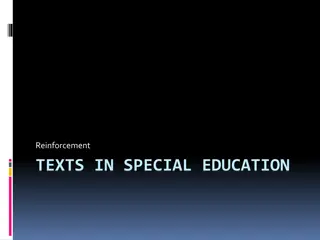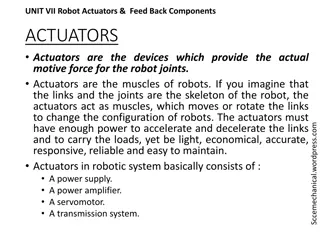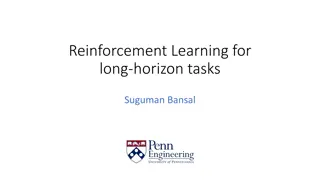Reproduction of Meta Reinforcement Learning for Optimal Design of Legged Robots
Our project aims to reproduce the Meta Reinforcement Learning process for optimal design of legged robots, focusing on understanding robot design parameters, algorithms, and optimization. We will explore Markov Decision Process (MDP), Model-Agnostic Meta-Learning (MAML), and design optimization techniques to train meta-policies and optimize design parameters. Evaluation will be done by comparing results with previous papers.
Uploaded on Feb 17, 2025 | 3 Views
Download Presentation

Please find below an Image/Link to download the presentation.
The content on the website is provided AS IS for your information and personal use only. It may not be sold, licensed, or shared on other websites without obtaining consent from the author.If you encounter any issues during the download, it is possible that the publisher has removed the file from their server.
You are allowed to download the files provided on this website for personal or commercial use, subject to the condition that they are used lawfully. All files are the property of their respective owners.
The content on the website is provided AS IS for your information and personal use only. It may not be sold, licensed, or shared on other websites without obtaining consent from the author.
E N D
Presentation Transcript
Reproduction of Meta Reinforcement Learning for Optimal Design of Legged Robots Shen Yining: 11911613 | Xu Zherui: 12011230 Yong Zhitao: 12110824 | Fan Wangzhuo: 12111942 Qiao Kai: 12211112 | Zhang Caomeng: 12112223 26thMarch 2024 AncoraSIR.com
Proposed Project Title Summary Our project mainly refers to the previous paper Meta Reinforcement Learning for Optimal Design of Legged Robots , attempting to reproduce the content of literature research. There are several problems centering robot design parameters: the correlation with the final output, the process of their determination, and the generalization of application. To solve these problems, we need to understand the method and algorithm for this paper and search some extra literatures about legged robots, machine learning, and Markov Decision Process (MDP). The data and parameters are from the paper we referenced. A base design comes from a robot currently being developed, which consists of ANYmal C main body with longer legs. The nominal length is 350 mm for both thigh and shank links, on the basis of simplified considerations similar to those mentioned in. Other parameters have also been considered, such as the gear ratio of the actuators, the geometry of the linkage transmission, the attachment point of the legs to the base, and the orientation of the first actuator. In addition, a simplified model for the velocity and torque limits of the real actuator is included in the simulation. All the policies are trained for N=2000 epochs using the same hyper parameters for PPO. Each epoch runs 1000 training environments with random velocity commands and terrain parameters. In terms of methods and algorithms, our project requires Markov Decision Process (MDP), Model-Agnostic Meta-Learning(MAML), and design optimization. MDP is a mathematical framework for formulating a discrete-time decision-making process which is commonly used in RL. The objective of RL is to obtain an optimal policy that maximizes the cumulative discounted rewards throughout interactions with its environment in an iterative fashion. The MAML approach is used to train our meta-policies. This approach enables fast fine-tuning to a task with a small amount of data possible during test time. And design optimization is to obtain a set of design parameters that maximizes a given fitness function by using CMA-ES for the optimization. We will evaluate our results by comparing them with the results and conclusions of previous papers. AncoraSIR.com Presenter Name & Date of Presentation Title of Your Presentation 2
What is the problem that you will be investigating? In the case of legged robots, these design parameters can include limb lengths, drive-train parameters such as gear ratio, and control parameters such as gait parameters and duration. The wide range of continuous and discrete design parameters results in a combinatorial problem with often unclear correlations between the design parameters and the resulting robot behavior , but often it is unclear how the final values (of the parameters) are determined since the motion parameters and simplified dynamics models are often developed/tuned for a certain instance by hand, it is hard to claim that the optimized motion is truly optimal for each design There are several problems centering robot design parameters: the correlation with the final output, the process of their determination, and the generalization of application. AncoraSIR.com Presenter Name & Date of Presentation Title of Your Presentation 3
What reading will you examine? To provide context and background Our project mainly refers to the previous paper Meta Reinforcement Learning for Optimal Design of Legged Robots , attempting to reproduce the content of literature research. In addition, we need to search literatures about legged robots, machine learning, and Markov Decision Process (MDP), to solve the problems we may encounter. AncoraSIR.com Presenter Name & Date of Presentation Title of Your Presentation 4
What data will you use? 1. A base design comes from a robot currently being developed, which consists of ANYmal C main body with longer legs. The nominal length is 350 mm for both thigh and shank links, on the basis of simplified considerations similar to those mentioned in. 2. Other parameters have also been considered, such as the gear ratio of the actuators, the geometry of the linkage transmission, the attachment point of the legs to the base, and the orientation of the first actuator. 3. In addition, a simplified model for the velocity and torque limits of the real actuator is included in the simulation. 4. All the policies are trained for N=2000 epochs using the same hyperparameters for PPO. Each epoch runs 1000 training environments with random velocity commands and terrain parameters. AncoraSIR.com Presenter Name & Date of Presentation Title of Your Presentation 5
What data will you use? References: [1] A. Ananthanarayanan et al., Towards a bio-inspired leg design for high_x0002_speed running, Bioinspiration & biomimetics, vol. 7, p. 046005, 08,2012. [2] Anymal - autonomous legged robot, May 2021. [Online]. Available:https://www.anybotics.com/anymal-autonomous- legged-robot. [3] J. Hwangbo et al., Per-contact iteration method for solving contact dynamics, IEEE Robotics and Automation Letters, vol. 3, no. 2, pp.895 902, 2018. [Online]. Available: www.raisim.com PPO hyperparameters AncoraSIR.com Presenter Name & Date of Presentation Title of Your Presentation 6
What method or algorithm are you proposing? Markov Decision Process(MDP): MDP is a mathematical framework for formulating a discrete-time decision-making process which is commonly used in RL. The objective of RL is to obtain an optimal policy that maximizes the cumulative discounted rewards throughout interactions with its environment in an iterative fashion. Fast Adaptation with Meta-learning: The Model-Agnostic Meta-Learning (MAML) approach is used to train our meta-policies. This approach enables fast fine-tuning to a task with a small amount of data possible during test time. Design Optimization: The goal is obtaining a set of design parameters that maximizes a given fitness function by using CMA-ES for the optimization. AncoraSIR.com Presenter Name & Date of Presentation Title of Your Presentation 7
How will you evaluate your results? We will evaluate our results by comparing them with the results and conclusions of previous papers. AncoraSIR.com Presenter Name & Date of Presentation Title of Your Presentation 8
Thank you for your listening! Team 2 ME 336 Spring 2024 AncoraSIR.com
